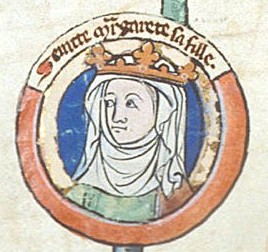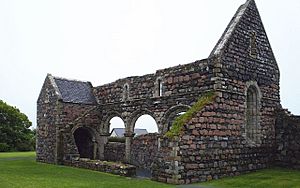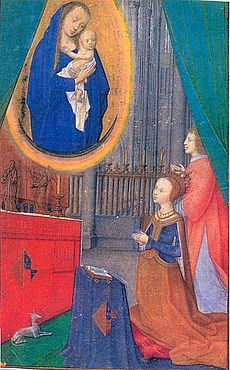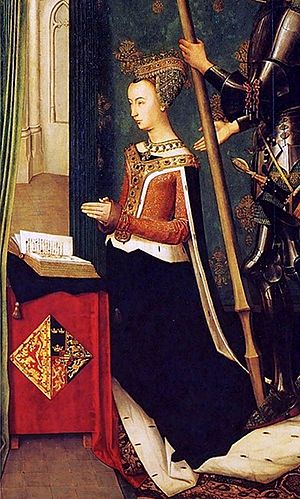Women in Medieval Scotland facts for kids
This article explores the lives of women in Scotland from the 400s to the early 1500s. This time is known as the Middle Ages. During this period, Scotland was a patriarchy, meaning men held most of the power and authority.
However, how this worked in daily life can be hard to fully understand. Many details we know about women from this time come from royal families. Some of these women became very important. Scotland had only one queen who ruled on her own during this time: Margaret, Maid of Norway (who ruled from 1286 to 1290). She was never officially crowned and her reign was short.
Some noble girls learned in nunneries, which were places where nuns lived. By the late 1400s, Edinburgh also had schools for girls. These were sometimes called "sewing schools." Wealthy families might have hired teachers for their daughters at home. But for most women, getting an education was very difficult. Even so, there are records of women who were Gaelic poets.
By the end of the Middle Ages, many young people in the Lowlands of Scotland worked as servants. They often left home to work in houses or on farms. They usually married later in life, often in their twenties. Women kept their own last names when they got married. While some noble girls married as teenagers, most women in the Lowlands waited until they were older. Divorce was not allowed, but in special cases, couples could get a legal separation.
In towns, many poor households were led by widows. These women earned money by doing odd jobs or selling food and ale. Sometimes, a craftsman's widow would continue her late husband's trade. Spinning thread was a common daily task for women of all social classes in towns. Women could sometimes be apprentices in crafts, but they usually couldn't join guilds (groups of skilled workers) on their own. Scotland had fewer nunneries than monasteries for men. However, prioresses (leaders of nunneries) had a lot of power. Some women chose to live as anchorites, dedicating their lives to God in isolation. Mary, mother of Jesus, was seen as a perfect example of a wife and mother, and was likely an important role model for women.
Contents
Women's Roles in Society

Medieval Scotland was a patriarchy, which means men held most of the power. Women had very limited legal rights. Daughters were expected to obey their fathers, and wives their husbands. Only widows could own property and represent themselves in legal matters.
It's hard to know exactly how this patriarchy worked in everyday life. Old poems often show women as passive figures. They were seen as objects of love or inspiration for brave knights. However, in historical stories like John Barbour's Bruce, women sometimes play a more active part. Women were also often seen as weaker, both morally and physically.
Royal Women and Queens

Many of the women we know about from the Middle Ages were part of Scotland's royal families. They were either princesses or queen consorts (wives of kings). Some of these women became very important in Scottish history. As mentioned, Margaret, Maid of Norway, was the only queen who ruled Scotland herself during this time.
The first wife of a Scottish king to be called "queen" in records was Margaret. She was an Anglo-Saxon princess who married Malcolm III. She was a very important political and religious figure. However, her high status was not automatically passed down to later queens.
Ermengarde de Beaumont, who was the wife of William I, was also notable. She acted as a mediator and a judge when her husband was away. She was the first Scottish queen known to have her own official seal.
Learning and Education
Girls from noble families sometimes went to school in nunneries. Examples include Elcho, Aberdour, and Haddington. By the late 1400s, Edinburgh also had schools for girls. These were sometimes called "sewing schools," which suggests sewing was a main activity. However, reading was likely taught there too. Lay women or nuns probably taught the students.
Wealthy families, including lords and rich townspeople, might have hired private teachers. This education could have included women. But for most women, chances to learn were very limited. Interestingly, a major collection of Medieval Scottish Gaelic poems, The Book of the Dean of Lismore, includes poems by at least four women. One of them, Aithbhreac Nighean Coirceadail (active around 1460), wrote a sad poem for her husband.
Marriage and Family Life
By the late Middle Ages, people in the Lowlands of Scotland often married later in life, usually in their mid-twenties. This was because they needed time to earn money and gather resources to start their own homes. Unlike in England, women in Scotland kept their original last name after marriage. Marriages were also meant to build friendships between different family groups.
Girls could marry from the age of 12, while boys could marry from 14. Many girls from noble families married in their teenage years. However, most women in the Lowlands waited until their twenties, after working for a period. There were strict rules about who could marry whom based on family ties. Because of this, many noble marriages needed special permission from the Pope. This permission could sometimes be used later to cancel a marriage if it became inconvenient, even though there was no divorce.
Work and Daily Life

In the Scottish countryside, many young people, both boys and girls, left home to work as servants. This was common from the 1500s onwards. Some women worked as wet nurses, feeding babies of noble or wealthy families. The important job of a midwife, who helped women give birth, was also only for women.
In towns, many poor homes were led by widows. They earned money from small jobs or by selling food and ale. Spinning thread was a daily task for townswomen of all social classes. Women could sometimes be apprentices in crafts, but they couldn't join guilds on their own. However, many widows continued their late husband's craft. Some women even worked and traded independently. They hired and trained employees, which could make them attractive marriage partners.
Religion and Faith
Scotland had fewer nunneries than male monasteries. About 30 nunneries have been found from the period up to 1300, compared to 150 in England. There were very few in the Highlands. Prioresses, like Anna MacLean (died 1543) of Iona Nunnery, had a lot of power. They appointed staff, managed lands and money, and guided the nuns.
There might have been a small number of anchorites. These were people who lived alone and dedicated their lives to God. However, they left very few records. The Virgin Mary, seen as the perfect wife and mother, was likely a very important role model for women. In towns like Perth, there is evidence that women, usually wives, helped support local altars and religious groups. They did this through their relatives or husbands, or by owning property.
In Perth, the main church had several altars dedicated to Mary. There was also a chapel for St. Anne, Mary's mother, and another for the Virgin's Holy House. Several monasteries around the town were also dedicated to the Virgin. Queen Margaret became very important after she was made a saint in 1250. Her remains were moved to Dunfermline Abbey, and she became one of Scotland's most respected national saints.
New religious practices linked to Jesus and the Virgin Mary arrived in Scotland in the 1400s. These included devotion to the Five Wounds of Christ, the Holy Blood, and the Holy Name of Jesus. New religious feasts also began, such as celebrations of the Presentation, the Visitation, and Mary of the Snows.
See also


